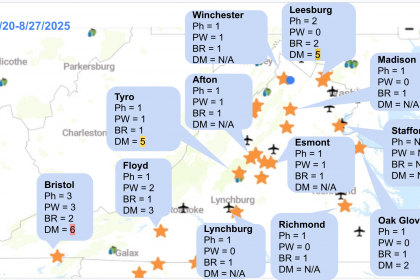Here’s a snapshot from the last week, showing the number of days with the risk of each disease: Ph = Phomopsis, PW = Powdery mildew, BR = Black rot, and DM = Downy mildew. This information was made available through the Wine Board-funded Sentinel Vineyard project.
It has been another dry week for the majority of the state. A few days with downy mildew and black rot risk across the state were observed, probably due to the rain event happened earlier this week. We are still in the critical period of cluster infections for downy mildew, powdery mildew, black rot, and Botrytis; thus, please protect your vines. I think we can relax six weeks after bloom, if this condition continues, but until then, please keep your guard up, just in case.

The image above is just a summary of the past seven days. These risk events help you understand what happened. However, preparing your sprays to protect your vines would be best. Please visit https://newa.cornell.edu/ to obtain more detailed information. You can check daily weather data and disease and insect pest model results, including forecasted risks. We paid the annual fee so that growers in Virginia could freely access NEWA. Speaking of forecast, it looks like we are expecting some rains next week. Let’s see…
One way to use this information is to adjust your spray intervals. If you see many days with disease risk(s), you may need to shorten your spray interval, or if you missed a material for downy mildew or black rot, you might wish to spray material(s) with kick-back activity. Or you may want to extend your spray interval, if you have not seen much risks as we have been experiencing this year.
It is essential to understand that the spray decision must be based not only on the weather condition but also on the cultivar and history of the disease(s) in your vineyard. Here’s a slide set from the previous virtual viticulture meeting for your information.
Last, but not the least, please keep eye on the 66-day PHI of mancozeb products. Some whites are getting close or passed the timing that you can use mancozeb to have 66 days to harvest. This year is a bit tricky with a longer flowering period, which is probably due to the warmer winter.





